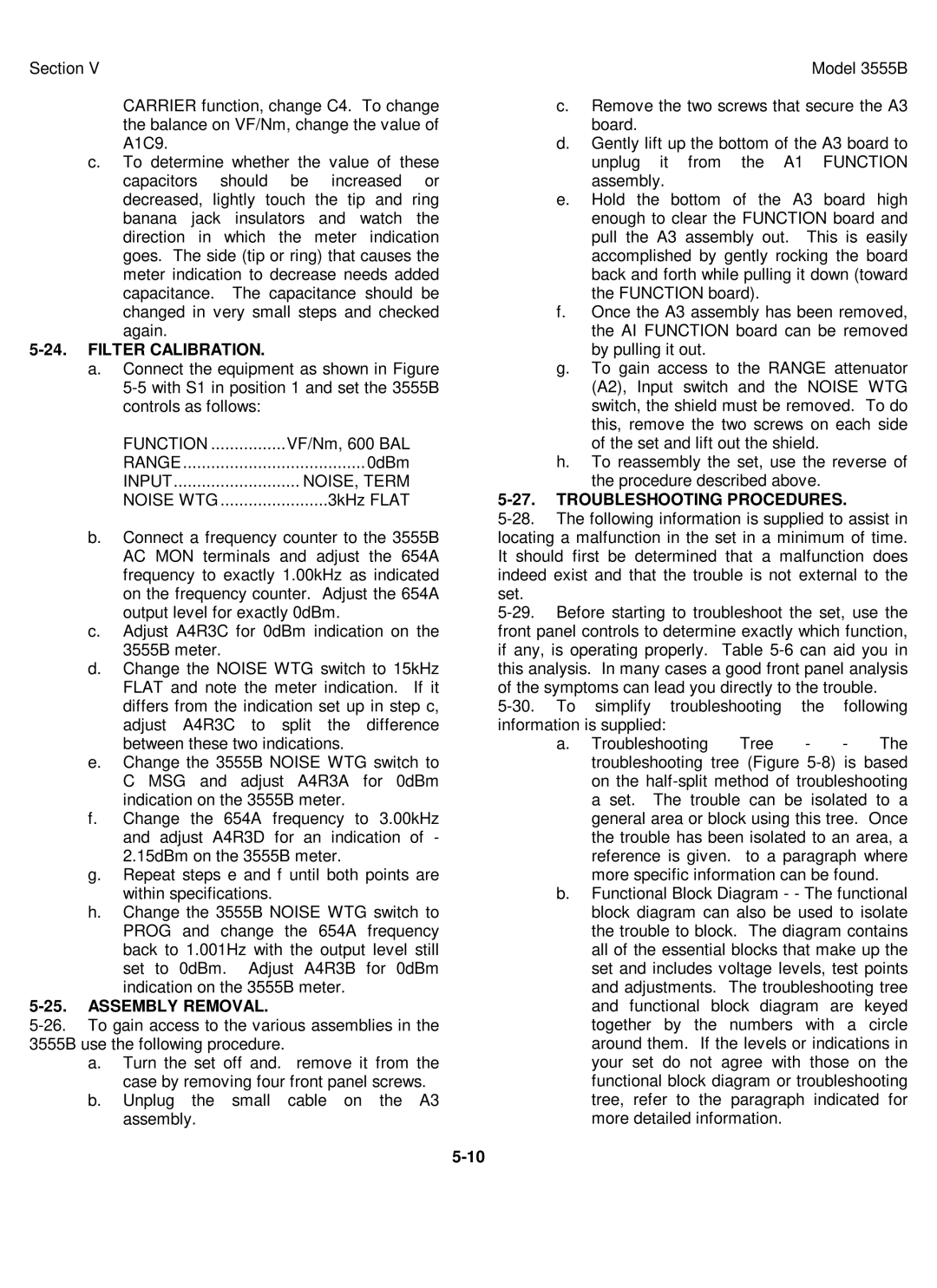Section V
CARRIER function, change C4. To change the balance on VF/Nm, change the value of A1C9.
c.To determine whether the value of these capacitors should be increased or decreased, lightly touch the tip and ring banana jack insulators and watch the direction in which the meter indication goes. The side (tip or ring) that causes the meter indication to decrease needs added capacitance. The capacitance should be changed in very small steps and checked again.
5-24. FILTER CALIBRATION.
a.Connect the equipment as shown in Figure
FUNCTION ................VF/Nm, 600 BAL RANGE ....................................... 0dBm INPUT........................... NOISE, TERM NOISE WTG .......................3kHz FLAT
b.Connect a frequency counter to the 3555B AC MON terminals and adjust the 654A frequency to exactly 1.00kHz as indicated on the frequency counter. Adjust the 654A output level for exactly 0dBm.
c.Adjust A4R3C for 0dBm indication on the 3555B meter.
d.Change the NOISE WTG switch to 15kHz FLAT and note the meter indication. If it differs from the indication set up in step c, adjust A4R3C to split the difference between these two indications.
e.Change the 3555B NOISE WTG switch to C MSG and adjust A4R3A for 0dBm indication on the 3555B meter.
f.Change the 654A frequency to 3.00kHz and adjust A4R3D for an indication of - 2.15dBm on the 3555B meter.
g.Repeat steps e and f until both points are within specifications.
h.Change the 3555B NOISE WTG switch to PROG and change the 654A frequency back to 1.001Hz with the output level still set to 0dBm. Adjust A4R3B for 0dBm indication on the 3555B meter.
5-25. ASSEMBLY REMOVAL.
a.Turn the set off and. remove it from the case by removing four front panel screws.
b.Unplug the small cable on the A3 assembly.
Model 3555B
c.Remove the two screws that secure the A3 board.
d.Gently lift up the bottom of the A3 board to unplug it from the A1 FUNCTION assembly.
e.Hold the bottom of the A3 board high enough to clear the FUNCTION board and pull the A3 assembly out. This is easily accomplished by gently rocking the board back and forth while pulling it down (toward the FUNCTION board).
f.Once the A3 assembly has been removed, the AI FUNCTION board can be removed by pulling it out.
g.To gain access to the RANGE attenuator (A2), Input switch and the NOISE WTG switch, the shield must be removed. To do this, remove the two screws on each side of the set and lift out the shield.
h.To reassembly the set, use the reverse of the procedure described above.
5-27. TROUBLESHOOTING PROCEDURES.
a. Troubleshooting Tree - - The troubleshooting tree (Figure
b.Functional Block Diagram - - The functional block diagram can also be used to isolate the trouble to block. The diagram contains all of the essential blocks that make up the set and includes voltage levels, test points and adjustments. The troubleshooting tree and functional block diagram are keyed together by the numbers with a circle around them. If the levels or indications in your set do not agree with those on the functional block diagram or troubleshooting tree, refer to the paragraph indicated for more detailed information.
